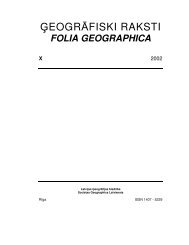eogrÄfiski raksti folia geographica xii - Ä¢eogrÄfijas un Zemes zinÄtņu ...
eogrÄfiski raksti folia geographica xii - Ä¢eogrÄfijas un Zemes zinÄtņu ...
eogrÄfiski raksti folia geographica xii - Ä¢eogrÄfijas un Zemes zinÄtņu ...
You also want an ePaper? Increase the reach of your titles
YUMPU automatically turns print PDFs into web optimized ePapers that Google loves.
LANDSCAPES AND CULTURE<br />
Clarence J. Glacken and his Traces on the Rhodian Shore (1967). At the end of the stay at L<strong>un</strong>d<br />
I presented my research findings to Thorsten Hagerstrand’s “Theoretical Seminar.” The theme<br />
was the poet Sylvia Plath and her perceptions of culture—nature relationships. This was<br />
followed by the publication of an essay on Antoine de Saint-Exupery (1990). I was diverted by<br />
Latvian independence, which inspired me to publish on Latvian landscape themes and also to<br />
write a book (in Latvian) on the so-called “Berkeley School of Landscape Studies” [B<strong>un</strong>kse<br />
1998]. But then I set out in earnest, and, along the way, with the help of some very sage advice<br />
from two anonymous reviewers, I dared to write Geography and the art of life [B<strong>un</strong>kse 2004], a<br />
book that, for better or for worse, I wrote as literature. The rest of this essay tells the story of its<br />
making and examines the methodology involved in writing such a work.<br />
The Story<br />
To write a book on geography as literature has meant stepping outside the norms of the field of<br />
geography; to go outside the given culture of geography into which we are domesticated by our<br />
teachers and by the practices that we learn from within the field of geography.<br />
The leitmotif of the book is how a human perceives and makes sense of his or her situation in<br />
landscapes and places; and literary-poetic expression of such sensibilities. It is, quite literally,<br />
an exploration John Kirtland Wright’s idea of “Geography that is fo<strong>un</strong>d in the mind and heart of<br />
every human being” [Wright 1966, 87-88]. As organizing principles I used two archetypal<br />
human realities: home and road. (Geographers abstract home and road into what Vidal de la<br />
Blache called “patterns of civilization” and circulation –Buttimer 1971, 5). As in my earlier<br />
research on Sylvia Plath, I intended to use literary and poetic sources in order to develop a kind<br />
of phenomenology of home and road. Gaston Bachelard’s The poetics of space was a major<br />
guidepost [Bachelard 1969].<br />
Exploring the human realities of home and road seemed a good plan. I recognized that I was<br />
getting into vast arena with many different meanings and viewpoints, often ambiguous and<br />
contradictory. (A secure home may turn into the most insecure and awful road; a road-literally<br />
or metaphorically – may become a secure home for some individuals.) It was my intent to have<br />
a rough plan of chapters, but to explore the themes of home and road inductively, in the process<br />
of writing. In hindsight, this was a most fort<strong>un</strong>ate procedure.<br />
In this manner two chapters were written and duly submitted for anonymous review. In order to<br />
set the stage, the front part of the first chapter (on geographic sensibilities) was written entirely<br />
from personal experience, with little or no references to secondary sources. The review came<br />
back with a positive evaluation, with the advice to base more of the material on my own<br />
experiences and perceptions, with literary citations as secondary sources. The reviewer also<br />
helped me steer clear of the well-trodden path of didactic moralizing about environmental<br />
issues.<br />
Thus encouraged I proceeded to write three more chapters, drawn on my own experiences, but<br />
still relying heavily on secondary literary sources. I was clearly reluctant to let go of the security<br />
provided by following the accepted practice of geographic scholarship. Again the manuscript<br />
was sent out for anonymous review. This time the reviewer was truly enthusiastic, except for<br />
chapter four, which had too many well- known literary sources. Why not jettison them and write<br />
entirely from personal experience, which, in this reviewer’s opinion, had produced some<br />
memorable results? Finally convinced of the merit of my own thoughts and literary sensibilities,<br />
I wrote an entirely new fourth chapter, filled out the other chapters with personal experiences<br />
and observations, and wrote an additional sixth chapter, which was required by the new<br />
structure of the work. In the end it is a book that largely researches and expresses the<br />
geographies within myself, with citations from other sources serving as backup material.<br />
Methodology<br />
Geography and the Art of Life is the author’s self-geography. Home and road provide the<br />
organizing principles. Under these rubrics the development of the author’s geographic<br />
sensibilities is observed: during WWII in Latvia and Germany, in exile in Germany and the<br />
USA, and during the return to the homeland (Latvia). The themes of the book (chapters) are as<br />
follows: (1) geographic sensibilities; (2) learning about landscapes; (3) you cannot go home;<br />
86

















